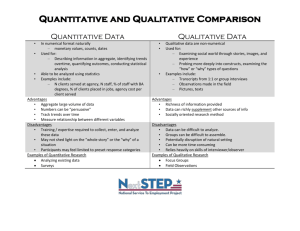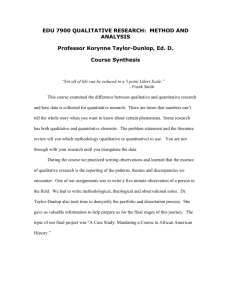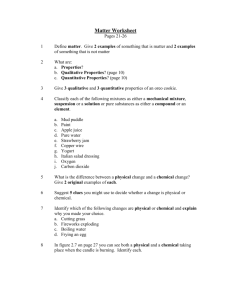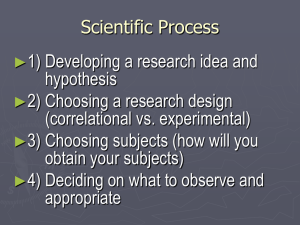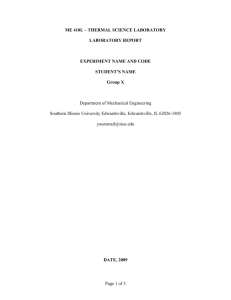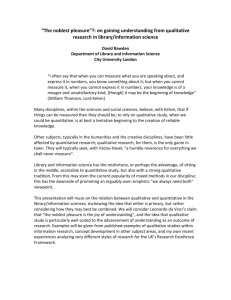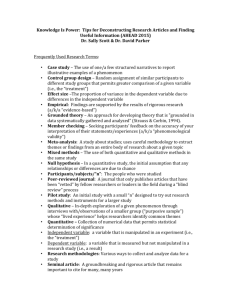Overview of Qualitative Research
advertisement
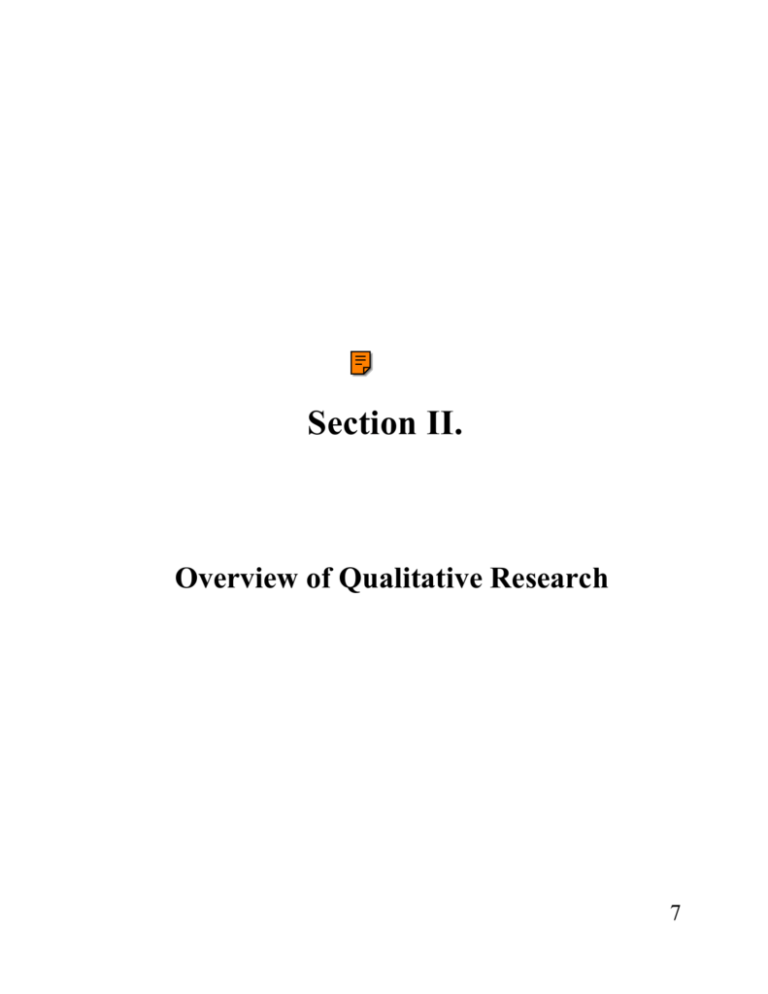
Section II. Overview of Qualitative Research 7 Qualitative Research Methods • These are research methods which obtain a lot of in-depth information from people. The aim is to understand WHY people think and behave the way they do. Because we spend a lot of time with people to get this information we usually can only talk with a FEW people. • This is different from quantitative methods like surveys. Here we obtain relatively little detailed information from each person. This is because with quantitative methods we interested in describing WHAT people do - their situation (things like how many people have had vaccinations, how many people know about ORS) - without really wanting details about why the situation is like that. Because we need less time with people to get this information, we can interview A LOT OF people. • Both qualitative and quantitative methods are important, and whether we use one or the other depends on what we are trying to learn. 8 Use of Qualitative Methods Necessary for planning & managing health, development & transition programs at the community level: • Identify the community’s overall priorities for development and the ranking of specific sectors • Identify community’s priorities within specific sectors/issues • Identify the underlying reasons for specific problems before developing solutions • Identify the community’s language, concepts and beliefs surrounding specific behaviors/situations targeted for change; and, • Assess stakeholder reactions to our programs to adapt implementation 9 PHASES OF THE PROJECT CYCLE PHASE Pre-project Project Design INFORMATION NEEDED Issues to address in project RRA/PRA* Specific factors for change Baseline surveys of: - Household factors - Quality and access to services - Environmental factors Qualitative study of factors Why factors occur and barriers to change Implementation End of project HOW Secondary data analysis Are we doing the right things, in the right way at the right times? Monitoring: - Quality of activities - Stakeholder reactions to activities -Progress toward objectives The effect and/or impact of the project? Final surveys Assess changes in quality of life 10 (subjective) * italics: indicates that qualitative methods are useful for the task Use of Qualitative Methods Pre-Project Phase Examples TASK Assess problems of overall concern to the target population; the ranking of these problems; the ranking of specific sectoral issues. METHOD Qualitative study: Rapid Assessments; Participatory learning tools EXAMPLE Matrix ranking exercises with 3 community groups identified “lack of income” as a higher priority problem than “health/illness,” “education,” and “transportation difficulties.” TASK Assess problems of most concern to target population within a specific sector or issue (e.g. health, agriculture, education); ranking of problems within that sector; relationship to general problems of concern to community METHOD Qualitative study: Rapid Assessments; Participatory learning tools EXAMPLE Free Listing interviews of “most serious illnesses” affecting children with 10 individuals in each of three areas of the project identified measles, pertussis, and diarrhea with vomiting as most serious. Dysentery, malaria and pneumonia were not considered among the “most serious illnesses” by many people. 11 Use of Qualitative Methods Project Design Phase Examples TASK Assess environmental risk factors related to the problems chosen for intervention in the proposal; SELECT Target risk factors. METHOD Qualitative study: Direct Observation, Participatory learning tools EXAMPLE Direct observation (by a Walkabout) identified contamination of water sources by human feces and lack of handwashing facilities as likely causes of high diarrhea prevalence. TASK Assess beliefs and attitudes and values underlying community behaviors that a project has selected for change. METHOD Qualitative mini-studies: Rapid Assessments, Participatory learning tools EXAMPLE Key informant interviews and focus groups with caretakers identified that caretakers do not seek medical treatment for children with dysentery because they do not consider dysentery very serious and because the local health center usually does not have drugs. 12 Use of Qualitative Methods Monitoring and Evaluation Phase Examples TASK Monitor stakeholder reactions to project activities, levels of participation in program METHOD Qualitative mini-studies: Rapid Assessments, Participatory learning tools EXAMPLE Group discussions with mothers discover that some mothers are reluctant to use project services because the mothers feel they are treated rudely by project workers and ‘looked down upon.’ TASK Assess stake-holder reactions to project effects at the project end METHOD Qualitative mini-studies: Rapid Assessments, Participatory learning tools EXAMPLE Matrix ranking of key community problems carried out at the end of a water and agricultural extension project no longer indicate that “distance to water sources” is a priority community problem as it was at the beginning of the project. 13 BIAS DEFINITION: CAUSES: x x x x 14 Triangulation (From Freudenberger, 1998) Reduce bias by: wUsing team members with different experiences and perspectives wContinuously cross-checking information using different methods and types of informants s Actively identify bias at the end of each day s Decide how to manage bias in days ahead Team Composition • Multidisciplinary • Gender • Insiders/Outsiders Types of Informants • women & men • young & old • different ethnic groups • different SES groups • Notables and typicals • Specialists (key informants) Methods & Techniques • Interviews (group & individual) • Numbers of informants • Diagrams • Ranking exercises • Calendars/timelines • Grouping exercises • Vary times of data collection Note: See the CRS Manual for RRA and PRA, pages 16-26 15 Things We Do in Qualitative Research • Triangulate our information - by methods, makeup of team, type of informant • Be flexible - take out or add in questions/methods as the study progresses • Use an iterative process - within & between interviews, within the study • Use open-ended approaches - allow understanding of the wider context; let the informant lead 16 Types of Informants in Qualitative Research Number interviewed in average study Number of times interviewed in a study Type of interview Key Informant Informant 2-8 5-15 4+ 1-4 General & Focused Focused 17 Comparing Qualitative & Quantitative Research General Methods Sampling Context Qualitative Quantitative Insider’s Perspective Outsider’s Perspective Exploratory Confirmatory Hypothesis Generating Hypothesis confirming Words Numbers Less Structure More Structure Dynamic Static Small Large More depth Less depth Purposive, Random Random Rich Less Rich Multiple Single 18 Purposive Sampling • Choose informants who have special knowledge of what you want to study • Sampling Units: w w w w Persons Times/days (e.g. morning vs. evening activities) Events/Episodes (e.g. births, illnesses, meals) Sites/microsites • Those with special local knowledge of our training study topics: X X X X X X X X 19
